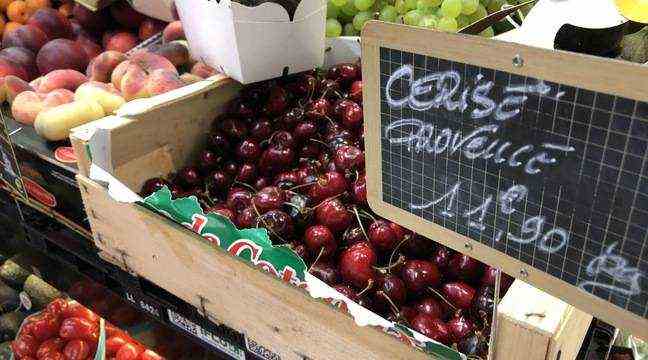From the country of Arles to the Southern Alps via the Val de Durance, a sudden and lasting cold hit Provence in early April. Three months later, farmers and consumers notice the damage. “It’s a disaster for everyone”, sums up Nicolas Savier, arborist based in Mazan, at the foot of Mont Ventoux. On its 20 hectares of cherry trees, it records 95% losses. “We went down to -6.5 degrees in April for a few nights,” he recalls. And after having burned 10,000 euros worth of candles, he decided “to stop the costs. Under these conditions, below -5, there is nothing to do ”. Like him, Mendy Montolin, his operating neighbor, who also cultivates apricots and figs on 17.5 hectares, “has lost everything”. To supply her direct sales store, she buys the few remaining cherries from her neighbors to sell them at 8 euros per kilo, “against 4 euros usually”.
In all stores, the price of summer fruit is soaring. Stéphane Guy works for Jeanningros, a wholesaler of the Arnavaux market of national interest in Marseille, a sort of local version of Rungis. “It’s very complicated to sell French product. The prices are very high, around 30% more expensive and there is little volume ”. Unsurprisingly, this year even more, “people are turning to Spain for supplies,” notes this wholesaler whose annual turnover exceeds 30 million euros.
For an equivalent category, prices vary from single to double. Thus, for example, the kilo of Spanish category 1 cherries, caliber 26 millimeters, sells at wholesale prices at 3.71 euros excluding tax against 8.28 euros for the French, according to data from FranceAgrimer, a public establishment attached to the ministry. of agriculture. In 2020, at this time, these same cherries were trading at 4.12 euros.
“Recurring climatic concerns for 10 years”
In a study published mid-June, Agrest, the statistical studies service of the Ministry of Agriculture takes a close look at apricot production. The production of this year is announced for France as “the weakest for at least forty-six years”, predicts the authors of the study. A bad harvest naturally explained by “the historic spring frosts, in particular in the Rhône Valley and in Provence”. With an estimated 6,400 tonnes, the Paca region recorded a 59% drop in its apricot production compared to the five-year average. The Auvergne-Rhône-Alpes region, in particular the Provençal Drome, is, for its part, even more severely affected with a loss of 73% for 15,700 tonnes expected.
In this context, France should see its trade balance in this market continue to widen, which had already imported more than 19,000 tonnes of Spanish apricots in 2020.
After the frosts, politicians and government representatives traveled to different farms to provide support and promises. Already affected by the frost last year, Christine Chaix, installed on the Manosque side said “to have received this month 40% of the amount of aid granted for last year”. “It’s very long, you have time to stop breathing. We must not wait for that to eat, “understood this lifelong peasant who has observed” recurring climatic concerns for ten years. It is hot in February and March, things are blossoming, then we have a return of the cold ”. The damage is there. In Provence, cherries and apricots no longer have the peach.

